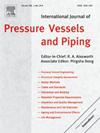Study on elastic-plastic behavior of X80 high-strength steel
IF 3
2区 工程技术
Q2 ENGINEERING, MECHANICAL
International Journal of Pressure Vessels and Piping
Pub Date : 2025-06-02
DOI:10.1016/j.ijpvp.2025.105571
引用次数: 0
Abstract
To improve the forming accuracy of high-strength high-strength steel, it is essential to thoroughly understand its elastoplastic behavior. The key is to study the quantitative relationship between the microstructure and mechanical properties of high-strength steel and to gain a deep understanding of the evolution of its elastoplastic mechanical properties under different stress conditions. Based on this, this paper focuses on dual-phase (B + PF) X80 high-strength steel and relies on the micromechanical phase dislocation constitutive theory. By comprehensively utilizing multi-scale experimental data, a 3D Representative Volume Element (RVE) finite element model based on the actual microstructure was established. The varying elastic modulus was embedded into the finite element model through a user-defined field subroutine. A total of 9 different stress states were experimentally tested and 15 types of numerical simulations were conducted to investigate the evolution of the yield behavior and nonlinear elastic behavior of high-strength steel, providing further guidance for the manufacturing and forming processes of high-strength steel. Ultimately, dual-phase (B + PF) X80 high-strength steel exhibited anisotropic yield surfaces under different stress states, and the subsequent yield surfaces demonstrated an evolution law of distortional hardening. The finite element model developed in this study achieved an average subsequent yield point error rate of only 5.79 %. Differences were observed in the nonlinear transition points under different stress states and pre-strains, with the nonlinear elastic points always lying within the corresponding yield surfaces for each stress state and pre-strain, showing softening phenomena. The nonlinear elastic surfaces also followed the evolution law of distortion. These findings aim to further guide the manufacturing and forming processes of high-strength steel.
X80高强钢弹塑性性能研究
为了提高高强度高强度钢的成形精度,必须深入了解其弹塑性特性。关键是研究高强钢的微观组织与力学性能之间的定量关系,深入了解不同应力条件下高强钢弹塑性力学性能的演变规律。基于此,本文以双相(B + PF) X80高强钢为研究对象,依托微力学相位错本构理论。综合利用多尺度实验数据,建立了基于实际微观结构的三维代表性体积单元(RVE)有限元模型。可变弹性模量通过用户自定义字段子程序嵌入到有限元模型中。通过9种不同应力状态的试验测试和15种不同的数值模拟,研究了高强钢屈服行为和非线性弹性行为的演变规律,为高强钢的制造和成形工艺提供指导。双相(B + PF) X80高强钢在不同应力状态下屈服面表现出各向异性,随后屈服面表现出变形硬化的演化规律。在本研究中建立的有限元模型获得的平均后续屈服点错误率仅为5.79%。不同应力状态和预应变下的非线性过渡点存在差异,各应力状态和预应变下的非线性弹性点均位于相应的屈服面内,呈现软化现象。非线性弹性曲面也遵循变形演化规律。这些发现旨在进一步指导高强度钢的制造和成形工艺。
本文章由计算机程序翻译,如有差异,请以英文原文为准。
求助全文
约1分钟内获得全文
求助全文
来源期刊
CiteScore
5.30
自引率
13.30%
发文量
208
审稿时长
17 months
期刊介绍:
Pressure vessel engineering technology is of importance in many branches of industry. This journal publishes the latest research results and related information on all its associated aspects, with particular emphasis on the structural integrity assessment, maintenance and life extension of pressurised process engineering plants.
The anticipated coverage of the International Journal of Pressure Vessels and Piping ranges from simple mass-produced pressure vessels to large custom-built vessels and tanks. Pressure vessels technology is a developing field, and contributions on the following topics will therefore be welcome:
• Pressure vessel engineering
• Structural integrity assessment
• Design methods
• Codes and standards
• Fabrication and welding
• Materials properties requirements
• Inspection and quality management
• Maintenance and life extension
• Ageing and environmental effects
• Life management
Of particular importance are papers covering aspects of significant practical application which could lead to major improvements in economy, reliability and useful life. While most accepted papers represent the results of original applied research, critical reviews of topical interest by world-leading experts will also appear from time to time.
International Journal of Pressure Vessels and Piping is indispensable reading for engineering professionals involved in the energy, petrochemicals, process plant, transport, aerospace and related industries; for manufacturers of pressure vessels and ancillary equipment; and for academics pursuing research in these areas.

 求助内容:
求助内容: 应助结果提醒方式:
应助结果提醒方式:


